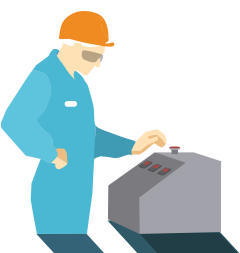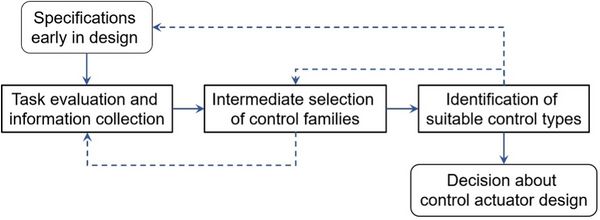Control Actuator Design Principles
Control actuators constitute the control actuating systems of machines as human interaction interface that serve worker task performance.
The correct selection of control actuators is the selection according to ergonomic design principles. This is important to ensure safe and efficient operation. Therefore, designers and manufacturers are well advised to follow a systemic and iterative approach in Figure 1 to select manual controls related to
- task evaluation and information collection
- intermediate selection of control families
- identification of suitable control types
Task evaluation and information collection expects to evaluate the general and specific task requirements and to determinate possible characteristics of restriction of movements and grip.
Intermediate selection of control families matches general task requirement and movement characteristics to select suitable control families referring to grip characteristics.
Identification of suitable control types matches specific task requirement and grip characteristics with the suitable control types to allow choosing the control actuator in ergonomic design for the task.
Designers and manufacturers are required to describe the human task to be performed by use of the prospective control actuator. A detailed description of the task should contain:
- The person involved (e.g., the worker operating the machine),
- the machine or device addressed (e.g., the kneading machine) and
- an interaction activity of the worker (e.g., powering the motor of the machine on and off).
- Workers tasks, each in one short sentence (e.g., worker powers on and off the machine with a control actuator).
References
- EN 894-1:1997+A1:2008 - Safety of machinery - Ergonomics requirements for the design of displays and control actuators - General principles for human interactions with displays and control actuators. Brussels: CEN.
- EN 894-2:1997+A1:2008- Safety of machinery - Ergonomics requirements for the design of displays and control actuators - Displays. Brussels: CEN.
- EN 894-3:2000+A1:2008 - Safety of machinery - Ergonomics requirements for the design of displays and control actuators - Control actuators. Brussels: CEN.
- Lee, J.D., Wickens, C.D., Liu, Y. & Ng Boyle, L. (2017). Designing for People: An Introduction to Human Factors Engineering. CreateSpace: Charleston.
- Proctor, R.W. & van Zandt, T. (2018). Human factors in simple and complex systems. Boca Raton: CRC Press.
- Woodson, W.E. & Conover, D.W. (1973). Human engineering guide for equipment designers. Berkeley: University of California Press.


